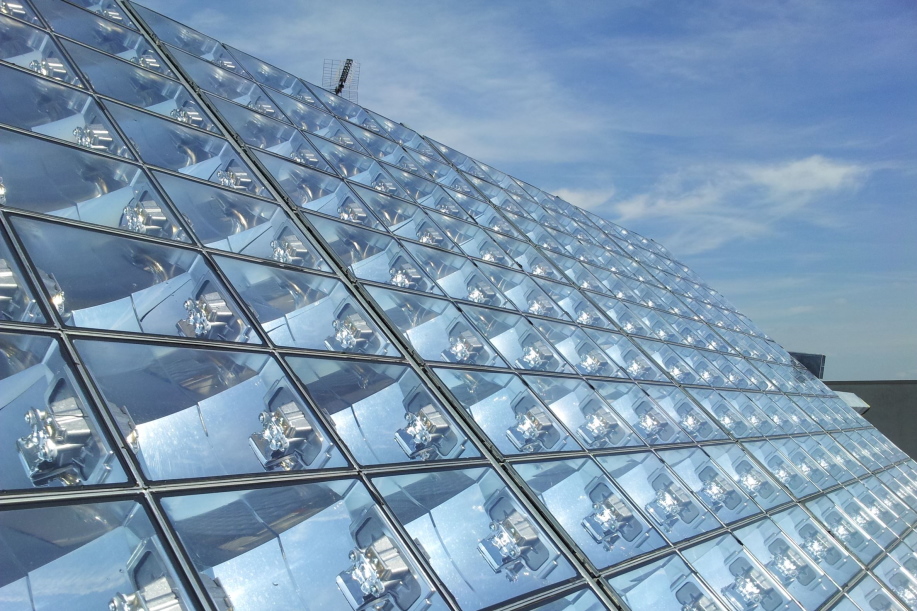With concentrated photovoltaic solar power systems, we commonly define a technology that has a higher capacity to exploit the sun’s rays compared to the traditional one.

More specifically, this system can produce energy with a higher level of efficiency at a significantly lower price when compared to conventional systems. A concentrated photovoltaic solar power system is made based on an immediate conversion of the sun’s rays into electrical energy by using the photovoltaic effect. Even though today, this system is particularly advantageous, it is not used as often as flat technology. However, it is expected that in the future, it will gain a substantial market share due to its increased efficiency.
Functioning and technical specifications
Unlike traditional photovoltaic, concentrated photovoltaic (CPV) solar power systems exploit:
• modules to convey sunlight through, with mirrors and lenses. These reflect the sun’s rays on high-efficiency photovoltaic cells that can quickly transform them into clean energy;
• inverters (one or more as needed) that convert the current from DC to AC;
• minor electrical components such as protections, wiring, and much more.
The capacity to reduce the area of the photovoltaic cells in use and the ability to concentrate light on a chosen area, allows, besides increasing the energy conversion efficiency, to reduce the consumption and wear of the semiconducting material. The most significant effect of these features is that production costs can be significantly reduced. The lower part of the photovoltaic cells was engineered so that the accumulated heat could be dissipated appropriately without compromising the quality of the system itself. A concentrated photovoltaic (CPV) solar power system is mounted on the entire structure and is adequately dispersed throughout.
What technologies are used?
A concentrated photovoltaic solar power system mainly uses two types of systems: high concentration (HC) and low concentration (LC).
The first requires high accuracy and precision in terms of pointing the sun’s rays. This is why it is essential to use a tracking system that uses dual-axis technology.
The second system, on the other hand, uses a single-axis tracking system since it does not require a pointing accuracy as precise as that of the first case. The versatility of the CPV also enables the development of the technology to positively influence other sectors that are not solely and strictly energy-related, such as mechanics, nanotechnology, and optics.
What makes concentrated photovoltaic solar power systems so competitive?
The panels are made using less silicon and are, therefore, cheaper overall. The system can also be installed on surfaces with reduced size, as the system is only 2 cm thick, and the multi-junction solar cells are only half a square millimetre wide. The photovoltaic cells are also capable of high performance, even in low solar radiation conditions. Therefore, even under severe conditions, the concentration system can provide plenty of clean energy.
What precautions to take when dealing with concentrated photovoltaic (CPV) solar power systems
The high efficiency of a concentrated photovoltaic solar power system requires, on the other hand, the respect of particular precautions to guarantee its excellent functioning and increase its durability. First of all, it should be remembered that lenses and mirrors must be clear of dust and debris to perform their reflecting function efficiently. It is, therefore, essential to clean the system thoroughly for it to function to the best of its capabilities.
Another element to take into account is the potential overheating of the cells. That is why the system may require an adequate cooling system, which may consume energy.
The reliability of concentrated photovoltaic solar power systems
Concentrated photovoltaic solar power systems have reached a high degree of TRL maturity: Technology Readiness Level 9 on a scale from 1 to 9 (this corresponds to the maximum score for a real system tested in an operating environment).
Indeed, according to some research conducted on the use and functionality of different systems for the production of clean energy, a concentrated photovoltaic solar power system is 30% more efficient than a flat photovoltaic system. Not only that, if it were possible to lower the heating of the photovoltaic cells, this could also be higher than a flat photovoltaic system by a value equal to or greater than 73%.
Environmental impact
A concentrated photovoltaic solar power system has a limited impact on the environment because it consumes less semiconductor material than conventional photovoltaic. It is a system of renewable energy generation. For this very reason, the use of such a system in different areas, such as domestic or industrial, would make it possible to use almost exclusively zero-emission electricity, and therefore, to use green energy.
The RSE is one of the institutions that are most committed to the research of this system. The head of the High concentrated photovoltaic project, Salvatore Guastella, explains how the CPV shows high yields (in the laboratory they recorded up to 47%) and how a concentrated photovoltaic solar power system takes up less space for the same generated power. This is extremely important and needs to be taken into account, especially in a country like Italy, where land use must be limited.
